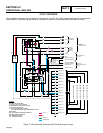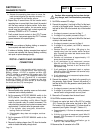
GENERAL
Test numbers in this section correspond to the
numbered tests in Section 3.3, “Troubleshooting
Flow Charts”. When troubleshooting, first identify
the problem. Then, perform the diagnostic tests in
the sequence given in the flow charts.
TEST 26 – CHECK VOLTAGE AT TERMINAL
LUGS E1, E2
DISCUSSION:
In automatic mode, the standby closing coil (C2) must
be energized by standby generator output if transfer to
the “Standby” source is to occur. Transfer to “Standby”
cannot occur unless that power supply is available to
the transfer switch.
*
DANGER: BE CAREFUL! HIGH AND
DANGEROUS VOLTAGES ARE PRESENT
AT TERMINAL LUGS E1 AND E2 WHEN
THE GENERATOR IS RUNNING. AVOID
CONTACT WITH HIGH VOLTAGE TERMINALS
OR DANGEROUS AND POSSIBLY LETHAL
ELECTRICAL SHOCK MAY RESULT. DO
NOT PERFORM THIS VOLTAGE TEST WHILE
STANDING ON WET OR DAMP GROUND,
WHILE BAREFOOT, OR WHILE HANDS OR
FEET ARE WET.
PROCEDURE:
1. If the generator engine has started automatically (due to
a utility power source outage) and is running, check the
position of the generator main circuit breaker. The circuit
breaker must be set to its “On” or “Closed” position.
After confirming that the generator main circuit breaker
is set to ON (or closed), check the voltage at transfer
mechanism Terminal Lugs E1 and E2 with an accurate
AC voltmeter or with an accurate volt-ohm-milliammeter
(VOM). The generator line-to line voltage should be
indicated.
2. If the generator has been shut down, proceed as follows:
a. On the generator control panel, set the AUTO-
OFF-MANUAL switch to OFF.
b. Turn off all power voltage supplies to the trans-
fer switch. Both the utility and standby power
supplies must be positively turned off before
proceeding.
c. Check the position of the transfer mechanism
main contacts. The moveable LOAD contacts must
be connected to the stationary UTILITY source
contacts. If necessary, manually actuate the main
contacts to the “Utility” power source side.
d. Actuate the generator main line circuit breaker
to its “On” or “Closed” position. The utility power
supply to the transfer switch must be turned off.
Figure 1. The Transfer Mechanism
UTILITY
CLOSING
COIL (C1)
STANDBY
CLOSING
COIL (C2)
BRIDGE
RECTIFIER
BRIDGE
RECTIFIER
MANUAL
TRANSFER
LEVER
LIMIT
SWITCH
(SW2)
N1
N2
E2
E1
T1
LIMIT
SWITCH
(SW3)
T2
N2A A
A
B
126
205
B
E2
Page 74
PART 3
TRANSFER SWITCH
SECTION 3.4
DIAGNOSTIC TESTS


















